The Fight Against P - Methamphetamine Awarenes
Methamphetamine abuse has become a tremendous challenge
for the entire Nation. Education, prevention, and community
involvement are key parts of our National Strategy to reduce
the demand for meth. People who know about the destructive
effects of meth on the user and the community, are far less
likely to use meth.
What Is Methamphetamine?
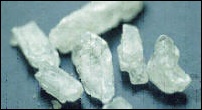 Methamphetamine is a
powerful, highly addictive stimulant drug that dramatically
affects the central nervous system. It is usually illegally
produced and distributed.
Methamphetamine is a
powerful, highly addictive stimulant drug that dramatically
affects the central nervous system. It is usually illegally
produced and distributed.
Meth comes in several forms, including powder, crystal, rocks, and tablets.
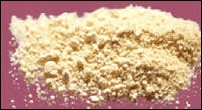 When it comes in the
crystal form it is called "crystal meth."
When it comes in the
crystal form it is called "crystal meth."
Meth can be taken by swallowing, snorting, smoking, or injecting it with a hypodermic needle.
How Is Meth Made?
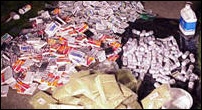 Unlike drugs such as
marijuana, cocaine, and heroin, which are derived from
plants, meth can be manufactured using a variety of store
bought chemicals.
Unlike drugs such as
marijuana, cocaine, and heroin, which are derived from
plants, meth can be manufactured using a variety of store
bought chemicals.
The most common ingredient in meth is pseudoephedrine or ephedrine, commonly found in cold medicine. Through a cooking process the pseudoephedrine or ephedrine is chemically changed into meth.
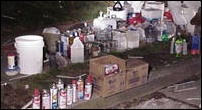 The ingredients that
are used in the process of making meth can include: ether,
paint thinner, Freon®, acetone, anhydrous ammonia, iodine
crystals, red phosphorus, drain cleaner, battery acid, and
lithium (taken from inside batteries).
The ingredients that
are used in the process of making meth can include: ether,
paint thinner, Freon®, acetone, anhydrous ammonia, iodine
crystals, red phosphorus, drain cleaner, battery acid, and
lithium (taken from inside batteries).
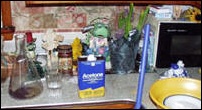 Meth is often
manufactured or "cooked" in very crude laboratories. Many of
these labs are not sophisticated operations and do not
require sophisticated chemistry equipment.
Meth is often
manufactured or "cooked" in very crude laboratories. Many of
these labs are not sophisticated operations and do not
require sophisticated chemistry equipment.
And the people who cook the meth usually do not have any chemistry training. Cooking meth is relatively simple, but highly dangerous and toxic.
There are two basic categories of meth labs:
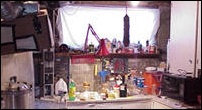 Superlabs produce
large quantities of meth and supply organized drug
trafficking groups that sell the drug in communities across
the U.S. Most of the larger labs are controlled by Mexican
Drug Trafficking Organizations operating in the U.S. and
Mexico.
Superlabs produce
large quantities of meth and supply organized drug
trafficking groups that sell the drug in communities across
the U.S. Most of the larger labs are controlled by Mexican
Drug Trafficking Organizations operating in the U.S. and
Mexico.
Small Toxic Labs produce smaller quantities of meth. These labs can be set up in homes, motel rooms, inside automobiles, and in parks or rural areas -- really almost anywhere.
How Does Meth Affect A User?
 Using meth causes an
increase in energy and alertness, a decrease in appetite,
and an intense euphoric "rush." That's in the short term.
Using meth causes an
increase in energy and alertness, a decrease in appetite,
and an intense euphoric "rush." That's in the short term.
With sustained use, a meth user can develop a tolerance to it. The user may take increasingly higher doses of meth trying to catch that high she first experienced. She may take it more frequently or may go on binges. She may change the way she takes meth.
For example a user may have started by taking a pill, but as she develops a tolerance she may begin injecting it. Addiction is likely.
 In the long term, a
person using meth may experience irritability, fatigue,
headaches, anxiety, sleeplessness, confusion, aggressive
feelings, violent rages, cravings for more meth, and
depression.
In the long term, a
person using meth may experience irritability, fatigue,
headaches, anxiety, sleeplessness, confusion, aggressive
feelings, violent rages, cravings for more meth, and
depression.
They may become psychotic and experience paranoia, auditory hallucinations, mood disturbances, and delusions. The paranoia may lead to homicidal or suicidal thoughts.
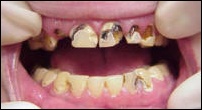 A fairly common
hallucination experienced by meth users is the so-called
crank bug. The user gets the sensation that there are
insects creeping on top of, or underneath, her skin.
A fairly common
hallucination experienced by meth users is the so-called
crank bug. The user gets the sensation that there are
insects creeping on top of, or underneath, her skin.
The user will pick at or scratch her skin trying to get rid of the imaginary bugs. This scratching can create open sores that may become infected.
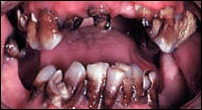 Meth reduces the
amount of protective saliva around the teeth. Meth users
also consume excess sugared, carbonated soft drinks, tend to
neglect personal hygiene, grind their teeth and clench their
jaws, leading to what is commonly called "meth mouth."
Meth reduces the
amount of protective saliva around the teeth. Meth users
also consume excess sugared, carbonated soft drinks, tend to
neglect personal hygiene, grind their teeth and clench their
jaws, leading to what is commonly called "meth mouth."
Teeth can eventually fall out of users' mouths--even as they do simple things like eating a sandwich.
High doses of meth can elevate body temperature to dangerous, sometimes lethal, levels. High doses can also cause convulsions.
People can die as a result of using meth.
Because meth is so addictive, the distance between the short and long term effects may not be very long.
How Does Meth Affect Everyone Else?
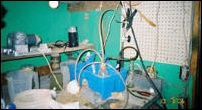 As you can imagine,
all those toxic chemicals used in the meth manufacturing
process take a toll on the environment.
As you can imagine,
all those toxic chemicals used in the meth manufacturing
process take a toll on the environment.
Every pound of meth made can generate up to five pounds of toxic waste that may seep into the soil and groundwater.
The manufacturing process also generates toxic fumes. These fumes can severely harm anyone exposed to them. Meth labs also generate highly explosive gases.
 Meth also has a very
serious impact on children. Many children are rescued from
homes with meth labs or meth using parents.
Meth also has a very
serious impact on children. Many children are rescued from
homes with meth labs or meth using parents.
Meth, chemicals, and syringes are all within reach of these children. Parents high on meth neglect their children. And the mental, physical, and emotional consequences for these Drug Endangered Children are often severe.
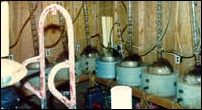 Millions of our tax
dollars are spent each year to clean up meth labs, to care
for Drug Endangered Children, and to pay for law enforcement
to deal with the meth problem.
Millions of our tax
dollars are spent each year to clean up meth labs, to care
for Drug Endangered Children, and to pay for law enforcement
to deal with the meth problem.
ENDS
More: Latest World News | Top World News | World Digest | Archives


 Aotearoa Healthcare Workers For Palestine: Wellington Healthcare Workers Demanding Overdue Government Action On Renewed Brutal Israeli Attacks On Gaza
Aotearoa Healthcare Workers For Palestine: Wellington Healthcare Workers Demanding Overdue Government Action On Renewed Brutal Israeli Attacks On Gaza WHO: WHO Continues To Urge China To Share Data Five Years After COVID-19
WHO: WHO Continues To Urge China To Share Data Five Years After COVID-19 WMO: 2024 To Become The Hottest Year On Record
WMO: 2024 To Become The Hottest Year On Record Save The Children: 2024 In Review - 35 Children Born Into Hunger Every Minute In 2024
Save The Children: 2024 In Review - 35 Children Born Into Hunger Every Minute In 2024 UN News: Haiti’s Destiny ‘Bright’ Despite Terrifying Escalation Of Violence
UN News: Haiti’s Destiny ‘Bright’ Despite Terrifying Escalation Of Violence UN News: Indian Ocean Tsunami Anniversary - A Call To Safeguard Future Generations
UN News: Indian Ocean Tsunami Anniversary - A Call To Safeguard Future Generations